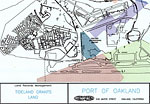|
The Public Trust Doctrine, established in constitutional law, provides
certain public access rights and restrictions for waterways, tidelands,
and lands created by filled waterways.
Oakland's Public Trust Lands
Oakland's waterfront
includes several regions of filled land that are protected under the
Public Trust. The Port of Oakland serves as trustee of these lands
under authority granted by the California State Lands
 Commission. Commission.
To get a sense of these trust lands,
view a 2001 Port of Oakland map of the Oakland
tideland grants land.
 (1MB)
(1MB)
Note that this Port map does not reflect changes since its 2001 date of
publication, including changes to a section of the Oakland Army Base
that was traded out of the trust in exchange for other land.
What is the Public Trust
Doctrine?
As we work to revitalize
our waterfront, development plans must conform to the Public Trust
Doctrine. The California State Lands
Commission, which
administers the Public Trust, has published California's
Public Trust
Doctrine
 and developed its
Public Trust Policy and developed its
Public Trust Policy
 . .
To facilitate broader
understanding of the Trust, the California State Lands Commission Staff
developed this
presentation of the Public Trust Doctrine
 ,
which was delivered in workshop settings in San Francisco, Los Angeles
and San Diego. ,
which was delivered in workshop settings in San Francisco, Los Angeles
and San Diego.
The following excerpt is
taken from a speech given April 20, 1998 to the League of Women Voters of Berkeley,
Albany, Emeryville by Sylvia McLaughlin, Save the Bay co-founder and
longtime Public Trust steward. The story of her contributions is
presented in the April 22, 2007 San Francisco Chronicle article:
How the bay was saved - Development threatened to fill it in.
Sylvia McLaughlin:
First of all, the Public
Trust Doctrine is not simple nor is it simple to explain. As a
non-lawyer, all I can do is try.
History. For the
history buffs among us, the Public Trust Doctrine comes to us from the
6th Century Roman Laws of Justinian which was a re-codification of the
2nd Century Greek philosophers. After inclusion in the Magna Carta in
1215, this Doctrine became part of English Common Law. From there, in
1776, it became a part of the legal structure of the 13 original
colonies and of our Federal government. In 1850, when California became
a state, it incorporated this English Common Law into its constitution.
Interestingly, when Texas joined the Union, in 1845, it opted for the
more Latin or Spanish/Mexican version of the Public Trust doctrine. It
is basically the same but with a few significant differences in certain
details, such as definition of the coastal boundary line. Under Common
Law, the King of England or Sovereign was the Trustee for public rights
in waterways. In this tradition, California's navigable waters or
Sovereign Lands became State property and are held by the State in trust
for all the people of the State.
Definition. In
coastal areas, "Sovereign Lands" include both tidelands and
submerged lands from the shore to 3 miles into the Pacific Ocean.
Oil and gas wells within this area are therefore subject to the Public
Trust. Tidelands are defined as lying between mean high tide and
mean low tide. Submerged lands, naturally, are below mean low
tide. The beds of navigable lakes and rivers are also Sovereign Lands,
that is, under the Trusteeship of the Public Trust.
Authority of the
Public Trust. The permitted uses of lands which come under the
jurisdiction of the Public Trust are: commerce, navigation,
fisheries, ecological habitat protection, water-oriented recreation and
preservation of land in its natural condition.
Since 1938, the State Lands
Commission has served as the administrator and guardian of these
valuable public lands. The State Lands Commission is composed of: The
Lieutenant Governor, the State Controller and the Director of Finance.
Please remember this when you vote! For the last several
administrations, the State Lands Commission staff has been under-funded
and under-staffed. We are fortunate to have at the State Lands
Commission a staff that is competent and dedicated, and that is a
pleasure to work with.
|